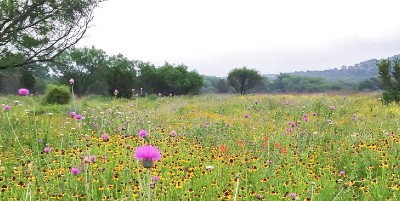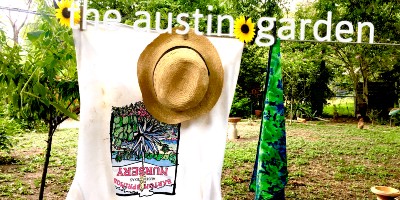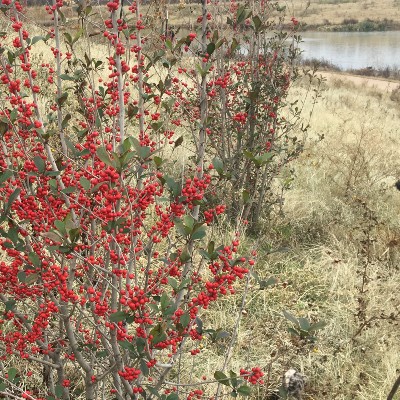RESOLUTIONS FOR 2023
Happy new year! Let's check in with some local gardening luminaries, to see what they're going to be doing differently this year.

LORI DAUL (landscape designer/gardening coach)
1. For my own sanity and bank balance, I need to stop zone- pushing so much. We've been so spoiled by that long stretch of mild winters before 2021 and it really has made these last three difficult.
I replanted a few things that I loved that froze during Snowpocalypse – mahonias, olives, bamboo, etc., and they are all toast yet again. It's time for me to make sure the most important structural and focal point plants in my garden can deal with temperatures between zero and 120F.
2. Fewer plants in pots. It's just too much work during our summers, especially since I don't have irrigation. Plants in pots are also less winter hardy. I'm sick of dragging pots in and out, and so is my back. Come spring, I'm going to be selling and re-homing quite a few things from my collection.
3. No more thirsty plants unless they're in a pond or water feature. I lost literal weeks off my life dragging hoses around last summer. I'm not willing to do that again.
Sadly, that means my plant palette is going to shrink dramatically, which bums out my inner horticultural nerd quite a bit. But I've found that I really don't have the energy or enthusiasm to have a high maintenance garden when I also maintain client gardens. I'm afraid of burning out on gardening completely, especially with our summers getting hotter and the ongoing drought. Something's gotta give! ❦
 RENEE STUDEBAKER (writer & educator)
I'm concerned about how declining biodiversity is affecting birds. This year, I resolve to do more for the birds in my garden. Here's a good how/to overview from Texas Audubon about gardening for birds: Audubon. And here are some alarming stats from a recent report by KUT's Mose Buchele: Audubon Texas bird counts “have had five years in a row where declining species out-numbered increasing species. Ninety-one species (24%) were at their lowest level for the decade.” (pictured above: Commons Ford Park - a rewilding project of the Audubon Society) ❦
MINNETTE MARR: (plant conservationist, Lady Bird Johnson Wildflower Center)
My goal in my backyard wild-scape is to increase the floristic diversity. I focus on wild populations that occur in the canyon-lands along the Balcones Escarpment. My three primary targets for 2023 include broad-leaf four o’clock (Mirabilis latifolia), pineapple cactus (Coryphantha sulcata) and sweet mountain grape (Vitis monticola) pictured above.
The parent seeds will be collected from sites that are slated for development or under pressure from deer or wild hogs. The goal is to share seeds from the first generation growing in my backyard with native plant enthusiasts in my neighborhood for a seed increase program. ❦
HEATHER KENDALL (education and outreach coordinator, the Natural Gardener)
1. To experiment and grow new varieties of vegetable this year instead of sticking with old reliables. (photo: kohlrabi)
2. To be on the ball with pest control and take action as soon as I see a problem. Aphids reproduce exponentially. I know this, and yet still I wait until I see a lot before doing anything about them.
3. To be more ruthless getting rid of plants that aren’t doing well. I tend to nurse things along even when they are struggling when I should just compost them and put my efforts into growing new, better plants. ❦
_______________________________________________
GARDEN TRENDS 2023: it's the time of year when designers make educated guesses about things we might be doing this year. Is it swapping lawns for meadows, and going vertical? Garden Design Or is it an embrace of new Victorian garden styles, or Scandinavian Minimalism? Veranda (Monrovia) ❦ ________________________________________________
CENTRAL TEXAS GARDENER: learn from expert Austin Davenport about how to grow microgreens – those tiny young sprouts of vegetables and herbs that are tender, delicious and highly nutritious. He also shares a nifty wicking system for watering them. CTG ❦
 THE AUSTIN GARDEN relies entirely on support from its readers. Please consider making a donation today. ; - )

January in the Garden
by Chris Winslow
1. Plant a fruit tree. Many fruit tree varieties will arrive in local nurseries this month, and in February and March. Try apples, peaches, plums, persimmons, and pears.
________________________________________________
2. Prepare spring vegetable garden. I would recommend the solarization method to get rid of weeds. Till your garden with a mechanical tiller or a garden spade and water the area thoroughly. Cover with a clear plastic film and secure the perimeter with rocks or soil. The sun will raise the temperature in the garden soil to levels that will kill weeds and seeds. Allow the film to stay on for a month to six weeks. When removed, your garden will be weed free.
________________________________________________
3. Turn off sprinklers. Automatic lawn sprinklers should be set at a minimum or simply turn them off. (Turf grass is dormant.)
________________________________________________
4. Plant a tree. There is still time. Maybe you purchased a living tree for the holidays. Find that perfect spot, plant it and water it in.
________________________________________________
5. Catalog browsing. Find a comfortable armchair, and get to work! January is a good time to look through garden and seed catalogs to decide on varieties you want to grow this year. Starting a garden journal is a simple way to keep track of what you plant and what has been successful.
________________________________________________
6. Plant asparagus. Now is the time to prepare beds and plant. Three year asparagus crowns will arrive in local nurseries early this month. Beds should be dug deeply and filled with rich organic compost. Three year crowns will put you closer to harvest than seed grown.
________________________________________________
7. Onions are still possible. You still have the opportunity to produce large onions this year. Also you can plant turnips, collards, and radishes. From Rockport, Diane and I wish Austin gardeners a Happy New Year, with bountiful crops and flowers aplenty! ❦
|

